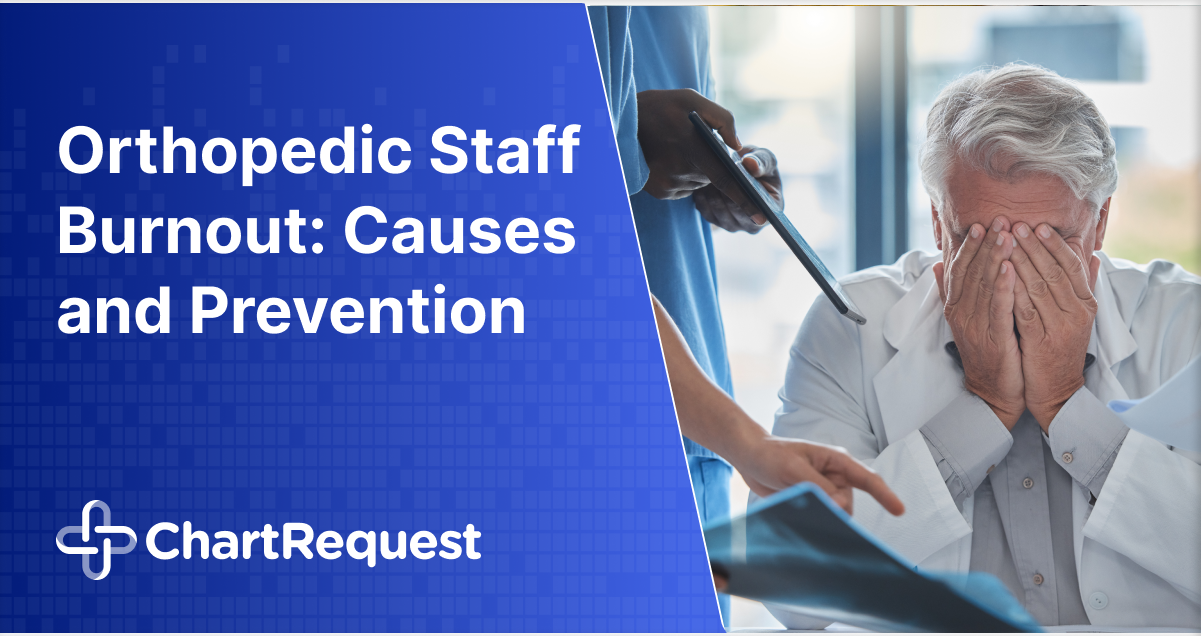Orthopedic administrative staff can be prone to burnout from balancing a steady flow of medical record requests with a mountain of other daily work.
Burnout doesn’t just harm morale for orthopedic staff: it can also lead to higher turnover, increased risk of human errors, and a drop in patient satisfaction. It leaves your best people feeling unseen replaceable.
In this article, we’ll discuss how automating administrative burdens eases orthopedic staff burnout.
Understanding Administrative Burnout in Orthopedic Clinics
Administrative staff in orthopedic clinics often juggle multiple responsibilities, including patient intake, imaging coordination, insurance processing, and a continuous influx of medical record requests. This relentless workload can lead to significant stress and exhaustion.
The World Health Organization identifies burnout through three key dimensions:
- Emotional Exhaustion – Feeling drained and unable to recover.
- Depersonalization – Developing a detached or cynical attitude toward patients and coworkers.
- Reduced Personal Accomplishment – Experiencing a sense that one’s work is no longer meaningful or effective.
These symptoms are indicative of systemic issues within the workplace. A 2023 MGMA Stat poll highlighted that 80% of medical group practice leaders reported increased levels of stress and burnout among their staff, primarily due to staffing challenges and escalating workloads.
Even the most dedicated employees can become overwhelmed when they lack the appropriate tools and support to manage their duties effectively.
Why Orthopedic Clinics Are Uniquely at Risk
Orthopedic clinics operate at the intersection of high volume and high complexity. The demand for medical and imaging records is nonstop, and the process can be complicated.
These requests come from every direction: fax, email, phone, walk-ins, and EHR portals. There’s no single workflow, just constant context-switching and pressure to keep up.
For front desk and HIM staff, that means:
- Frequent interruptions during check-ins or post-op scheduling
- No clear priority system for requests
- Endless toggling between systems and tasks
Inovalon highlights the impact of administrative inefficiencies in their white paper “Addressing the Critical Healthcare Worker Shortage.“
Workflow inefficiencies lead to a cascade of poor outcomes for both staff and patients. Inefficient workflows create bottlenecks across functions, increasing the administrative burden on healthcare workers and wasting time that could otherwise be spent on patient care.
When the work becomes repetitive, thankless, and overwhelming, orthopedic staff are prone to burnout. These practices must work tirelessly to meet release of information deadlines against a never-ending flow of requests. The intensity takes a toll.
The Hidden Costs of Ignoring Burnout for Orthopedic Staff
Burnout doesn’t always manifest as a dramatic breakdown. Often, it’s subtle: a missed record request, a curt interaction with a patient, or an overlooked compliance detail.
Over time, these minor lapses can escalate into significant operational challenges including but not limited to:
Turnover: Replacing a front-desk employee isn’t just time-consuming; it’s costly. The Society for Human Resource Management (SHRM) reports that the average cost to hire a new employee is approximately $4,129, with an average time-to-fill of 42 days.
Compliance Risk: Delays in providing patients with access to their medical records can lead to substantial penalties. The Office for Civil Rights (OCR) has imposed numerous fines on healthcare providers for failing to comply with the HIPAA Right of Access Initiative.
Reputation Damage: Consistent delays and errors can tarnish a clinic’s reputation. Referring providers may hesitate to send patients to a facility known for inefficiencies, impacting patient inflow and trust.
Team Morale Loss: Burnout is contagious. When one team member becomes disengaged, it can affect the entire team’s morale, leading to decreased productivity and increased turnover.
Addressing burnout isn’t just a human resources concern; it’s a critical operational imperative. Proactively implementing solutions can safeguard your clinic’s efficiency, compliance, and reputation and reduce overhead costs.
How No-Cost Record Release Automation Reduces Orthopedic Staff Burnout
Burnout thrives where outdated, manual processes go unchecked. ChartRequestSelect changes that. Instead of bouncing between inboxes, spreadsheets, and paper trails, staff manage every medical record request from a single, centralized dashboard.
ChartRequestSelect is a full-service solution that is purpose-built to meet the release of information demands of orthopedic practices.

By combining automation with human expertise, ChartRequestSelect removes the administrative drag that contributes to burnout and inefficiency. Orthopedic practices can enjoy these benefits and more:
- Enterprise-grade automation that eliminates repetitive, manual tasks
- Full-service ROI fulfillment—your staff reviews, we handle the rest
- Guaranteed 5-business-day turnaround times to meet compliance expectations
- Multi-site tracking and audit-ready reporting from a single dashboard
- White-glove support for your team and requestor community. See our reviews on Google!
This empowers your team to focus on what matters most: providing top-notch care and service for your patient community.
Support Your Team With ChartRequestSelect
Burnout doesn’t always show up as a breakdown. It starts with skipped lunches, late nights, and resignation letters. This risk can be eased with the right systems.
Modernizing record release sends a powerful message to orthopedic staff: “We see the strain, and we’re doing something about it.”
Curious how our no-cost release of information services can support your team? Schedule a personalized consultation today.


